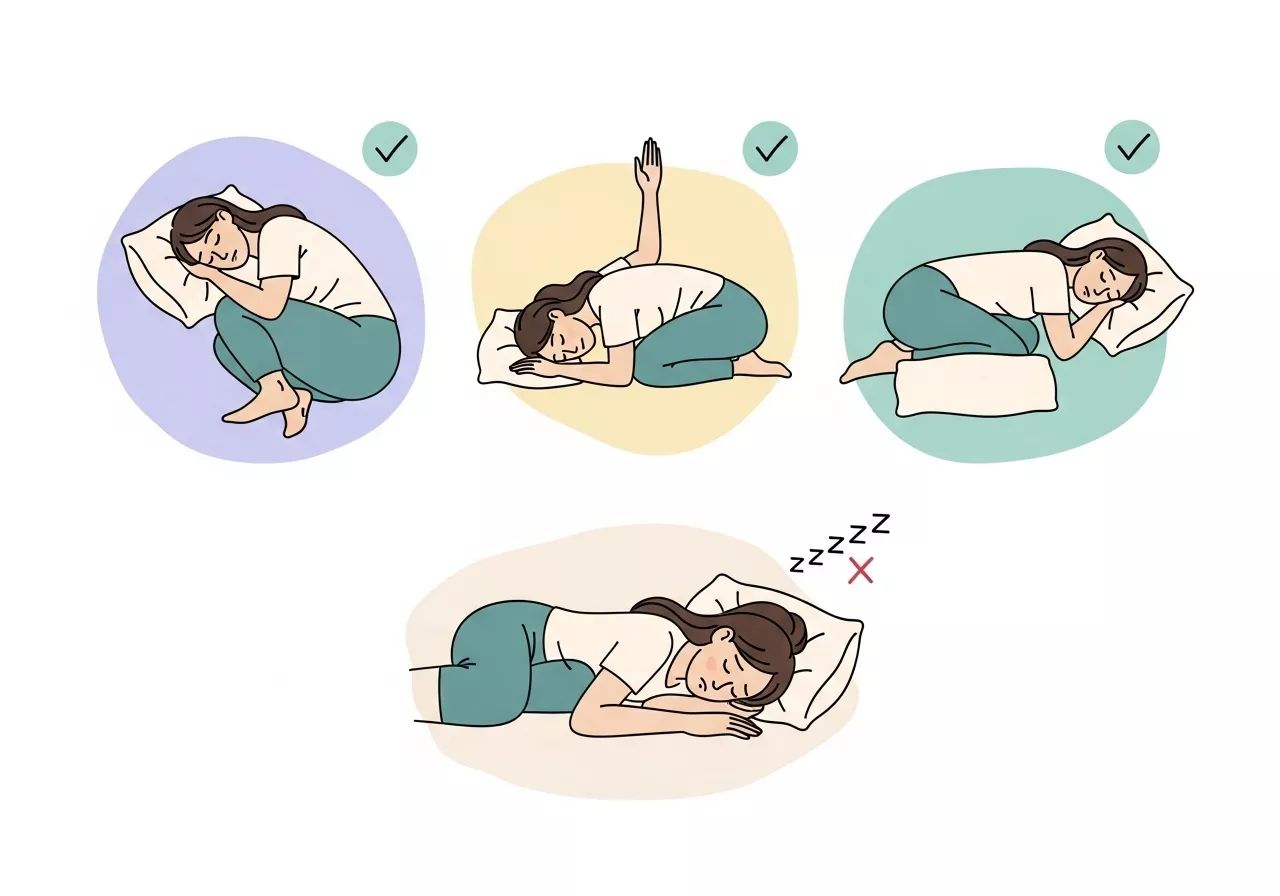The yoga squat, also known as Malasana, is a foundational pose in many yoga practices, but it’s not uncommon for practitioners, especially beginners, to find it challenging.
This difficulty typically stems from limitations in flexibility, strength, and alignment.

Understanding these obstacles and addressing them step by step can make this pose more accessible and comfortable.
Why Is Malasana Challenging?
1. Tight Hips
The yoga squat requires significant hip mobility. If the hips are tight, it becomes difficult to lower the pelvis while keeping the heels grounded.
This issue is common for those who sit for prolonged periods, as it causes the hip flexors and surrounding muscles to stiffen.
2. Restricted Ankle Mobility
Limited range of motion in the ankles, particularly in the Achilles tendon, can prevent the heels from staying on the ground during the squat.
This lack of flexibility makes it challenging to achieve stability and depth in the pose.
3. Stiff Knees and Calves
Tightness in the knees and calf muscles may hinder your ability to bend deeply into the squat. Pain or discomfort in these areas could discourage proper alignment and balance.
4. Foot Positioning Issues
Incorrect foot placement is another significant factor. Feet positioned too close together or pointed at an improper angle can lead to discomfort or instability.
Individuals with wider hips may particularly struggle without adjusting their stance.
5. Core and Lower Body Weakness
While flexibility is crucial, strength also plays a role. Weakness in the core, thighs, and glutes may result in an inability to support the body in a deep squat position.
How to Overcome Challenges in Malasana

1. Focus on Alignment
- Feet Placement: For individuals with wider hips, it is important to adopt a wider stance.
Position your feet slightly apart, pointing them outward at a 45- to 60-degree angle. Ensure your knees track over your toes (specifically the second or third toe) to avoid strain. - Heel Support: If your heels lift off the ground, use a folded mat, blanket, or yoga block beneath them to provide stability.
2. Improve Flexibility
- Hip Openers: Incorporate hip-opening stretches such as Pigeon Pose, Butterfly Pose, or Lizard Pose into your practice.
- Calf and Ankle Stretches: Perform stretches targeting the calves and Achilles tendon, such as Downward Dog or a wall-assisted ankle stretch.
3. Build Strength
- Engage the Core: Strengthening your core muscles can improve balance and stability. Plank pose and Boat pose are excellent options.
- Thigh and Glute Activation: Strengthen your thighs and glutes with exercises like Chair Pose, Lunges, and Bridges.
4. Use Props for Support
- Sit on a yoga block or bolster to ease the transition into the squat while maintaining proper alignment.
- Utilize the wall for support by practicing a supported squat with your back leaning against the wall.
5. Practice Mindfully
- Avoid rushing into the pose; instead, move slowly and intentionally to find your balance and alignment.
- Breathe deeply to release tension in the muscles and focus on creating space in the hips and ankles.
6. Stretch the Knees Gently
- Perform knee-friendly stretches such as Seated Forward Bend or Half Hero Pose.
If you experience persistent knee discomfort, consult a yoga instructor or a physical therapist to tailor your practice.
What Are the Common Mistakes in Malasana?

When practicing Malasana (yoga squat), certain mistakes can hinder progress, cause discomfort, or even lead to injury.
Being aware of these common errors and learning how to correct them ensures that you perform the pose safely and effectively.
1. Incorrect Foot Placement
- Mistake: Feet are placed too close together, pointing straight forward, or misaligned with the knees. This can create instability and unnecessary strain on the knees and ankles.
- Solution: Adjust your stance to suit your body structure. If you have wider hips, take a broader stance.
Turn your feet outward at a 45- to 60-degree angle and ensure your knees track in line with your toes (second or third toe specifically).
2. Lifting the Heels Off the Ground
- Mistake: Heels lifting during the squat indicate tightness in the calves, Achilles tendons, or ankle joints. This compromises balance and alignment.
- Solution: Place a folded blanket, rolled-up towel, or yoga block under your heels for support.
Gradually work on ankle mobility exercises, such as calf stretches and pointing-and-flexing movements, to improve flexibility.
3. Rounding the Back (Loss of Spinal Alignment)
- Mistake: Slouching or rounding the back during Malasana can reduce the pose’s effectiveness and strain the lower back.
This typically happens when practitioners collapse their chest or fail to engage their core. - Solution: Lengthen your spine by lifting your chest and engaging your core muscles. Imagine creating space between each vertebra as you extend upwards.
Practicing poses like Cat-Cow and Cobra Pose can help you develop spinal awareness.
4. Knees Collapsing Inward
- Mistake: Allowing the knees to cave inward places excessive pressure on the joints and reduces the pose’s stability.
- Solution: Actively press your knees outward toward the same direction as your toes.
If this is challenging, use a yoga strap looped around the thighs to provide resistance and help you keep the knees aligned.
5. Forgetting to Engage the Core
- Mistake: Neglecting to engage the core can make it harder to balance and hold the pose. Without core engagement, the pose relies solely on the legs, which may cause unnecessary fatigue.
- Solution: Gently draw your navel toward your spine to activate your core. This creates stability and reduces strain on your lower back.
6. Straining the Neck
- Mistake: Looking too far upward or downward can strain the neck muscles and disrupt the natural alignment of the spine.
- Solution: Keep your gaze neutral, looking forward or slightly downward. Maintain the natural curve of your neck in line with your spine.
7. Holding the Breath
- Mistake: Many practitioners unconsciously hold their breath while focusing on the pose, which increases tension and reduces relaxation.
- Solution: Practice deep, steady breathing. Inhale to lengthen the spine and exhale to release tension and sink deeper into the squat.
8. Ignoring Props and Modifications
- Mistake: Attempting the full version of Malasana without props or modifications, despite tightness or discomfort, can lead to improper form or injury.
- Solution: Use props like yoga blocks under your sitting bones, blankets for heel support, or even practice a supported squat against a wall to build strength and flexibility over time.
9. Overlooking Individual Anatomy
- Mistake: Forcing your body into a specific alignment or depth without considering your unique anatomy can lead to pain or frustration.
- Solution: Understand that everyone’s body is different. Experiment with your stance width, foot angle, and squat depth to find what feels most comfortable and stable for you. Seek guidance from a yoga instructor if needed.
By identifying and correcting these common mistakes in Malasana, you can deepen your practice, prevent injury, and reap the full benefits of this foundational yoga pose.
Remember, progress comes with patience, awareness, and consistency.
Can Malasana Reduce Belly Fat?
Malasana (yoga squat) is not a direct fat-burning exercise, but it can play a role in supporting weight loss, including reducing belly fat, as part of a comprehensive fitness routine and healthy lifestyle.
While spot reduction (targeting fat loss in specific areas) is a common misconception, performing Malasana can help tone the core muscles, improve digestion, and enhance overall metabolism, which may contribute to reducing belly fat over time.
How Malasana Supports Belly Fat Reduction?
1. Activates Core Muscles
- Mechanism: While holding Malasana, you engage your core muscles to maintain balance and proper posture.
This consistent activation helps strengthen and tone the abdominal region. - Benefit: A stronger core not only improves posture but also supports better fat-burning during other physical activities.
2. Boosts Digestion
- Mechanism: The deep squat position gently compresses the abdominal region, stimulating the digestive organs, including the stomach, intestines, and liver.
This can promote better digestion and reduce bloating, which may make the belly appear flatter over time. - Benefit: Improved digestion aids in efficient nutrient absorption and waste elimination, both of which are essential for a healthy metabolism.
3. Improves Metabolism
- Mechanism: By activating large muscle groups such as the thighs, hips, and core, Malasana helps increase overall metabolic activity.
This can boost calorie burn and aid in weight loss when practiced regularly. - Benefit: A heightened metabolism contributes to fat loss, including in the belly area, when combined with proper nutrition and regular exercise.
4. Enhances Flexibility and Mobility
- Mechanism: Malasana stretches and strengthens the lower body and core, improving flexibility and functional movement.
A more flexible body allows for better performance in other high-intensity exercises, which can enhance overall fat loss. - Benefit: Increased mobility and strength make it easier to stay active and engage in calorie-burning activities.
5. Supports Stress Reduction
- Mechanism: Yoga poses like Malasana are known to activate the parasympathetic nervous system, reducing stress levels.
Chronic stress is linked to higher levels of cortisol, a hormone that can lead to increased belly fat. - Benefit: Reducing stress through yoga can help regulate cortisol levels, supporting fat loss efforts.
How to Maximize Belly Fat Reduction with Malasana
To optimize the effects of Malasana for reducing belly fat:
Combine with Cardiovascular Exercises
- Engage in cardio activities such as running, cycling, or brisk walking to create a calorie deficit.
Practice Consistently
- Incorporate Malasana into your daily yoga routine to build strength and flexibility over time.
Focus on Nutrition
- Maintain a balanced diet rich in whole foods, lean proteins, healthy fats, and fiber. Avoid processed foods and excess sugar, which contribute to fat storage.
Add Core-Strengthening Poses
- Combine Malasana with other yoga poses like Boat Pose (Navasana), Plank, and Warrior III to target the core more intensively.
Stay Hydrated
- Drink plenty of water to support digestion and metabolism, both of which are essential for fat loss.
While Malasana alone won’t directly burn belly fat, its benefits for core strength, digestion, metabolism, and stress reduction make it a valuable addition to a holistic approach to weight management.
To achieve noticeable results, combine Malasana with a healthy lifestyle, regular exercise, and mindful eating habits.
Key Takeaways
Mastering Malasana is a journey that involves cultivating patience and consistency. By addressing tightness, weakness, and alignment issues, you can gradually deepen your squat and enjoy its benefits, such as improved flexibility, better posture, and enhanced mobility in everyday life.
For even more insights on perfecting the yoga squat, check out detailed guides or seek personalized advice from a qualified yoga instructor.



